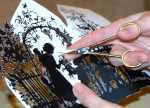A passion for paper -- Native of Germany enjoys traditional 'scherenschnitte' craft

What Vera Hanson does, she does with all her heart. Her hobbies -- crafting traditional German folk art dolls and creating "scherenschnitte" ("scissor cut") artwork -- become her passions.
For years, Vera, a native of Germany and a former Stratton-area resident, designed, crafted and sold her one-of-a-kind German dolls of burlap and traditional garb. These days, Vera, a McCook resident, concentrates on "scherenschnitte" -- the ancient art of cutting paper into decoration.
Vera said scherenschnitte can be traced back as far as 207 A.D. It found its way to America with German colonists, when mothers made homemade storybooks, with paper-cutting pictures, for their children. "They collected newspaper pictures or postcards or created their own patterns," Vera said.

Vera learned the traditional German folk art of scissor cutting in fourth and fifth grade art classes, she said, starting with simple cuts, or just an outline of something. "As children, we transferred our patterns with carbon paper and pencil," she said. Today, Vera uses a copy machine to makes enlargements, or to "mini-size" a pattern.
Scherenschnitte requires a specialized paper with a black velvet front surface and a white backing on which the pattern is printed. Patterns are available from craft companies; Vera purchases hers from a company in Florida. "I don't create my own patterns," Vera said, but she often personalizes them -- changing the size, adding or taking away a detail.
The scissors are sharp -- pointy, pointy sharp -- and range in price from $9 to $65. Some artists use hobby knives, but Vera said she is most comfortable with scissors.
Traditionally, the finished silhouette -- a velvety jet black -- is mounted on an ivory background and framed in black.
Vera recently wrote a short memoir of her scherenschnitte experiences, indicating that she welcomes a challenging design. "It gets especially hard when there isn't much paper left to cut, and my hands are holding nothing but limp paper lace," she wrote.
"Many times, after finishing a certain project, I say to myself, 'Never again will I do this pattern.' Yet, when I move one, I pick something more difficult again," she wrote.
"It's my passion," she smiles. "What can I say?"
Vera's favorite patterns are images of Christmas ("Weichnachten" in German), children and florals. "Anything relating to real life," Vera said. "Something pleasant to look at ... something interesting to stir up a memory."
Christmas patterns remind her of her childhood in Germany -- "the joy of it all, the secrecy that surrounds that time and the wonder of the story," she said. Her three children will inherit Vera's own collection of Christmas scherenschnitte pictures -- St. Nicholas, a manger scene, a Christmas tree, angels singing a lullaby to Baby Jesus and a Christmas angel.
Several of Vera's scherenschnitte creations hang in the lab waiting room at McCook Clinic. She has sold her pictures at craft and specialty shows. For years, she traveled to the yearly conventions of "Germans from Russia," many of whom purchased and carried her artwork from coast-to-coast.
Vera doesn't give scherenschnitte lessons, but is more than willing to help someone get started.
Vera says other people knit, or crochet, or embroidery, or paint. "I am a papercutter," she says.
She lives by the standards voiced by poet Maya Angelou: "Success is liking yourself, liking what you do and liking how you do it." Vera smiles and muses, "That's me."
